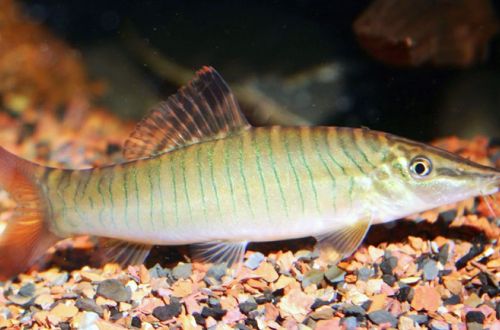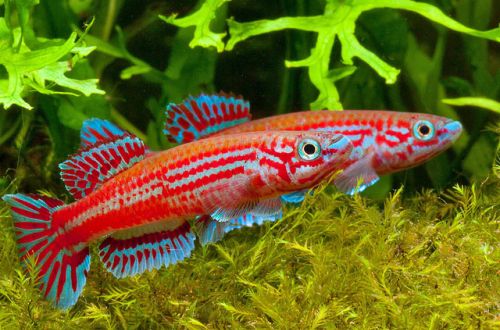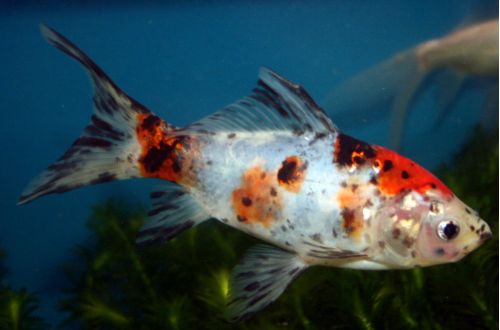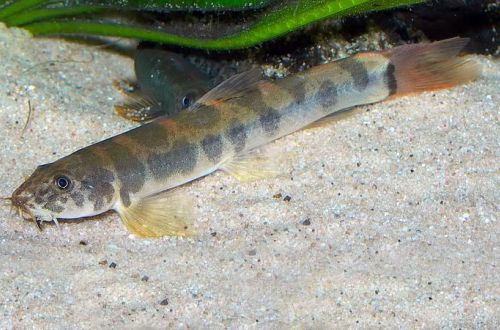
Botsia Tiger
Tiger botsia or Tiger botsilia, also known as Green tiger charr, scientific name Syncrossus hymenophysa, belongs to the Cobitidae (charr) family. The complex nature, requiring careful selection of neighbors, as well as not the simplest conditions of detention, limit the use of this fish in a community aquarium. Not recommended for beginner aquarists.

Contents
Habitat
It comes from the river systems of the islands of Sumatra and Kalimantan (Borneo), as well as from peninsular Malaysia. However, on the peninsula, wild populations have probably already disappeared, the last documented case dates back to 1955. They live in rivers and lakes, during the rainy season, as the surroundings closest to water bodies are flooded, they move into them to lay eggs. Thus, the natural habitat has many biotopes with different water conditions. As a rule, fish prefer to stay close to the shore among vegetation, submerged snags and other woody debris.
Brief information:
- The volume of the aquarium – from 300 liters.
- Temperature – 25-30°C
- Value pH — 5.0–7.5
- Water hardness – soft (1-12 dGH)
- Substrate type – sandy or fine gravel
- Lighting – subdued
- Brackish water – no
- Water movement – moderate / weak
- The size of the fish is 15–21 cm.
- Nutrition – any drowning
- Temperament – unfriendly
- Content in a group of at least 5–6 individuals
Description
Adult individuals reach a length of 15 to 21 cm, while females are noticeably larger than males. Other differences between the sexes are not so pronounced. In adult Tiger Bocilia, the color is yellowish with rows of thin vertical stripes of green. Young fish are gray, yellow shades appear as they grow older.
Food
Unpretentious to the diet look. Tiger Bocilia will accept most popular foods (dry, frozen and live). There are only two main conditions – they must be sinking and contain plant components. Once a week, you can offer pieces of fresh vegetables and fruits, such as cucumber, melon, spinach, zucchini.
Maintenance and care, arrangement of the aquarium
Recommended aquarium sizes for a group of 5-6 fish start at 300 liters. The decoration includes a sandy or chalk gravel substrate, some driftwood and areas with aquatic plants. In general, the choice of decor is not so important, the fish can successfully adapt to various conditions.
Water quality is of decisive importance for the maintenance of this species of char. It is impossible to allow the accumulation of organic waste and abrupt changes from the norm of the main hydrochemical indicators (pH and dGH). It is also necessary to provide a high content of dissolved oxygen, which can be difficult, since Tiger Botsia needs a high temperature. As you know, oxygen does not stay in warm water for a long time. In this case, an additional aeration system will help.
Behavior and Compatibility
Very unfriendly to smaller fish. They can also harm larger neighbors with long veil fins, such as ornamental golden roars, cockerels, etc. Joint keeping with species of comparable size that live in the water column or near the surface is allowed.
Intraspecific relationships are built on a hierarchy from stronger to weaker individuals. There were no conflicts among relatives. You should acquire a group of at least 5-6 fish, with a smaller number, the behavior becomes aggressive.
Breeding / breeding
In the wild, the spawning period coincides with the rainy season and is accompanied by the migration of fish to flooded areas, where eggs are laid. Thus, spawning is stimulated by a whole set of factors, which are problematic to recreate in the artificial environment of an aquarium. Mass breeding is carried out on specialized fish farms using hormonal injections.
Fish diseases
By their nature, non-ornamental fish species that are close to their wild relatives are quite hardy, have high immunity and resistance to various diseases. Health problems can be the result of inappropriate conditions, so before starting treatment, check the quality and parameters of the water. If necessary, bring all values back to normal and only then begin treatment, if necessary. Read more about diseases, their symptoms and methods of treatment in the section “Diseases of aquarium fish”.





